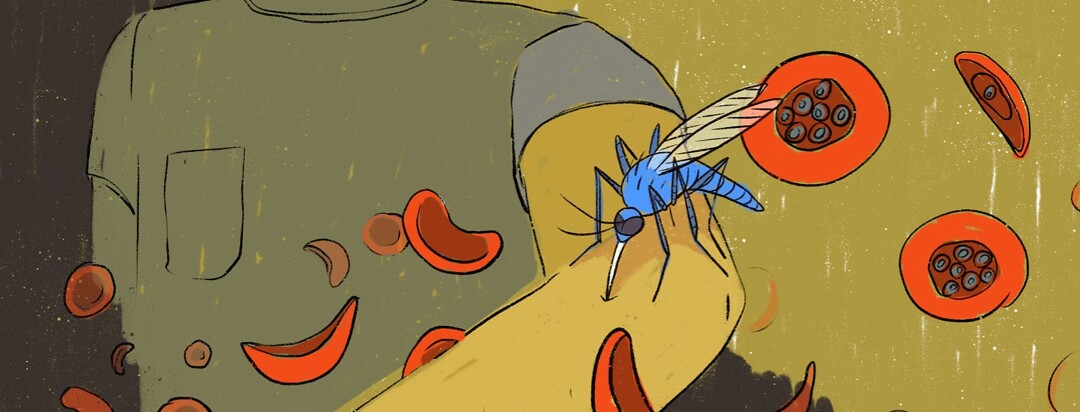Sickle Cell & Malaria
Sickle cell trait (SCT) is caused by a gene mutation. This mutation changes a protein (hemoglobin) in red blood cells. SCT is also referred to as HbAS.1-7
Those with SCT often have no symptoms because they have 1 altered gene and 1 normal gene. SCT began in places where malaria is common. SCT has a protective effect against malaria, a deadly disease affecting thousands of people. However, SCT does not offer any benefits to a person not living where malaria is a threat.1-7
What is malaria?
Malaria is a disease caused by a parasite called Plasmodium. These parasites live inside Anopheles mosquitos. When an infected mosquito bites you, parasites are transferred to you, multiply, and make you sick. Infected mosquitos pass parasites to many humans because the mosquitos do not get sick from the parasites. This helps malaria spread easily.1,2
Any exchange of infected blood can cause malaria. This means a mother can pass it to her unborn baby. Malaria also spreads through blood transfusions and sharing needles.2
In 2019, 409,000 people worldwide died from malaria. Most were children, but immunocompromised people and healthy people also passed away due to malaria. Anti-malarial drugs can treat the disease, but it is still deadly.1,2
Where is malaria found?
Malaria can be found in any tropical climate that allows parasites and Anopheles mosquitos to survive. It is most common in Africa, South America, and South Asia.1
What are the symptoms of malaria?
Common symptoms of malaria include:1-3
- Fever
- Chills
- Bad headaches
- Nausea, vomiting, and diarrhea
- Stomach, muscle, and/or joint pain
- Fast breathing and high heart rate
- Cough
- Tiredness
- Malnutrition
- Sweating
Severe cases of malaria can cause:1,2
- Low red blood cell counts (anemia)
- Brain issues
- Enlarged spleen and/or liver
- Acute respiratory distress syndrome (ARDS)
- Low blood pressure
- Metabolic acidosis
- Low blood sugar
- Kidney problems
- Blood clotting problems
How are malaria and sickle cell disease connected?
People with SCT are not as affected by malaria compared to those with normal hemoglobin. During infection, those with SCT have 50 to 90 percent fewer parasites in their blood than people with normal hemoglobin. People with SCT also get rid of the parasites faster. Compared to those with normal hemoglobin and malaria, people with SCT and malaria:1,3-7
- Have lower hospital admissions
- Have milder cases of malaria
- Have lower rates of blood transfusions
- Are less likely to die from malaria
- Are less likely to get bacteremia (blood infection)
How does sickle cell trait protect against malaria?
Malarial parasites invade normal red blood cells and rearrange their content. The parasites breed and produce proteins that make red blood cells sticky. These blood cells explode, releasing parasites capable of infecting other red blood cells.5,7
The misshapen hemoglobin of SCT affects a parasite’s ability to complete this cycle. The parasite triggers the SCT hemoglobin to sickle. The immune system then clears the infected red blood cells before the parasite can complete its life cycle and infect other red blood cells. This means fewer parasites and milder illness.5,7
The history of sickle cell trait and malaria
The places where malaria is most common are also the places that have the highest percentage of people with SCT. This is not by accident. Malaria is so deadly that the body came up with a way to fight it. By changing the genetic code of hemoglobin and causing SCT, the carrier has a better chance of surviving a disease with a high death rate.8
Does sickle cell anemia also protect against malaria?
Having sickle cell trait provides malarial protection, but having sickle cell anemia (HbSS) does not. A study of children in Kenya between 16 months and 2 years old showed that those with HbSS had the lowest chance of surviving malaria. However, kids with SCT had the highest chance of survival. Survival rates for those with normal hemoglobin were between those with sickle cell trait and HbSS.1
Why would there be a selection for a gene that causes sickle cell disease?
It seems illogical that SCT would continue to spread when it can cause sickle cell disease. SCT is an example of balanced polymorphism. This is when a genetic change is both good and bad. In this case, the good is protection against malaria. The bad is the chance of 2 people passing SCT genes to their child who will then have sickle cell disease.5,9
SCT came from places where malaria is the main cause of death, so anything that provides protection has a good chance of being passed on. However, in places where malaria is not a threat, having SCT is not helpful. It leads to sickle cell disease, which lowers life expectancy and causes major health problems.5

Join the conversation